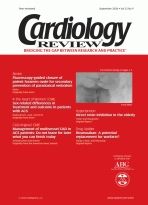Publication
Article
Cardiology Review® Online
Improving outcomes in coronary artery disease
Author(s):
The October issue once again features preparatory questions for the Maintenance of Certification Exam in Cardiovascular Disease, and then moves to another of our "Images in Cardiology." This time, an echocardiogram reveals the presence of a left ventricular thrombus postpartum in a 36-year-old woman, in a paper submitted by Cardiology Review reader Dr Dwarakraj Soundarraj and colleagues. Section editor Dr Tasneem Naqvi comments on unusual appearance of this mass and other possible diagnoses associated with it. In a combined lipid and coronary artery disease (CAD) article by Italian authors Drs Giuseppe Patti and Germano Di Sciascio, they discuss improved outcomes due to statins in patients with acute coronary syndromes undergoing early percutaneous coronary intervention. This randomized trial of 171 patients receiving either atorvastatin or placebo confirms the importance of the statins in this setting, as I emphasize in an accompanying commentary. Another paper that looks at combined subject areas (this time diabetes and CAD) is from Dr Richard M. Cubbon and colleagues from the United Kingdom. The authors analyzed the role of diabetes in affecting mortality after an acute myocardial infarction (MI) in more than 3000 patients between 1995 and 2003, and conclude that more effective diabetes-related management strategies should be implemented immediately after an acute MI. In my commentary, I ruminate on why diabetic patients with MI have not done better over time, despite technological advances. The 6-minute walk test is a simple procedure, useful for evaluating functional status in patients with chronic congestive heart failure. This month’s heart failure section looks at the prognostic value of this popular test in a large representative sample of 1592 patients who were older than patients reported in previous studies. For Dr Lee Ingle of the United Kingdom, the test turns out to be an important independent predictor of mortality in patients with at least moderate left ventricular systolic dysfunction (though not with lesser degrees). Dr Michael Rich details nicely the implications of this study for the practicing physician. In the hypertension section, Dr Robert N. Foley and associates evaluate the role of atherosclerotic renovascular disease—a major contributor to hypertension of renal etiology—in causing end-stage renal disease in the United States. The authors used dialysis data in 146,973 patients to confirm their hypothesis. Drs John Maesaka and Bill Miyawaki, a regular authorial dynamic duo for this journal, comment on this clinical epidemiologic study. Enjoy!
— Peter F. Cohn






